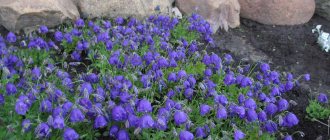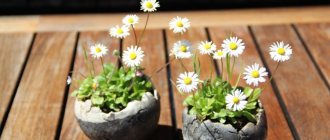Arctotis belongs to the Aster family. The genus includes about 70 plant species. Some species are endemic to the Cape region, approximately 30 species are native to Zimbabwe and Africa, and others grow in South America. The translation of the name arctotis from Greek is bear's ear, because the bush has dense pubescence. This plant has been cultivated for more than a century.
Author of the article
Maxim Sverchkov
Professional biologist and breeder with extensive experience and experience.
Description
- Under natural conditions, arctotis is a herbaceous plant or subshrub. Whitish, silvery pubescence is present on shoots with leaves.
- The leaf plates are arranged alternately or opposite each other. Inflorescences in the form of saucer-shaped baskets are five to eight centimeters in diameter.
- There are single flowers on long peduncles. They include ligulate pinkish, whitish, yellow flowers with tubular middle brownish flowers. Many scales are found in multi-row inflorescences.
- The fruit is brownish seeds and tufts. Seed germination lasts two years.
- This plant can be an annual, biennial or perennial. Perennial varieties grow as annuals in cold climates.
Where does the flower come from?
In nature, Arctotis is a herbaceous plant.
Arctotis is native to South Africa, where it grows on rocky slopes. Sometimes found in the southern regions of Zimbabwe and Angola on poor soils. Some species grow under similar conditions in South America. Therefore, Arctotis can be considered an unpretentious crop, but this does not mean that they do not require care.
Translated from Latin, Arctotis means “bear ear,” which is what it is sometimes called. Just not for the shape of the flower, but for the characteristic leaves. It is also called South African chamomile, and the hybrid varieties that are sold in flower shops are called gabris. This is a plant of the Asteraceae family.
In the wild, arctotis grows in the form of shrubs and even grass, but in gardens, when cultivated, it can grow as single large flowers.
Species of Arctotis
Short-stemmed Arctotis
It is a perennial. This is a compact bush, its height is fifteen centimeters. South Africa is the homeland of this variety.
Country of origin: South Africa. It is an annual (sometimes biennial) herbaceous plant with short roots and thin stems. The flowering period is from July to August. Height - no more than 15 centimeters. The oblong leaves are collected in a basal rosette. Along the edges there are small teeth. The surface is green, bright, with slight “pubescence” and slightly rough. The leaves below are also slightly pubescent with white hairs.
Flower baskets grow up to eight centimeters in diameter. At the same time, the flower stalks themselves are without leaves. The flowers are single-rowed at the edges, yellow or bright orange. They often have a blue spot at the base.
- Whitish felt pubescence is present on the foliage with shoots.
- The flowers have a bright orange color and are reed-shaped and edge-shaped.
- Cultivation began in the early 19th century.
Rough Arctotis
The height is forty to fifty centimeters. As an annual it grows in temperate latitudes.
Most often grown as an annual, height - no more than 50 cm. The stem is straight, branched. The root system is weak and fragile. It is best to grow such a plant in peat pots.
The leaves are hard, slightly rough. There is uneven pubescence. The shape is elongated, similar to an ellipse. The inflorescences are small. Flowers come in both white and yellow. Moreover, they all necessarily have a brown or yellow spot at the base. The middle flowers are always dark brown.
- Inflorescences in the form of baskets are 5 centimeters in diameter,
- consist of yellow tubular,
- yellow reed-shaped flowers,
- have brownish streaks.
Stemless Arctotis
Perennial with a powerful rod-type rhizome. The pinnately dissected foliage is approximately 0.2 meters in length. On the outside they are green, on the inside they are whitish due to pubescence.
This bright and original perennial flower has a fairly strong root core. The leaves are pinnate and slightly lobed. They can grow up to 20 centimeters in length. Green above, tinged white below with pubescence typical for this species.
The diameter of the inflorescences reaches five centimeters. The baskets are made up of reed flowers, painted yellow. All flowers have a purple lining.
- The baskets are approximately 5 centimeters in diameter.
- They consist of yellow flowers with a purple lining of the reed type, black-reddish flowers of the tubular type.
Stechasolifolia arctotis
It is a perennial, but in temperate climates it grows as an annual. The height of the green shoots of the erect type reaches one meter. They have pubescence, which is represented by a softish silvery pile. The leaves are dense and asymmetrical, they have a lanceolate shape with a wavy edge.
One of the most common cultivated plant species. It can often reproduce on its own, by seeds. Height - up to 1 meter. The stems are branched. The leaves on the stems are dissected and large. The shoots, like the leaf blades, always have a white edge, due to which the color of the entire plant acquires a silver tint.
Peduncles are long with single inflorescences. The flowers are white and have a small yellow spot at the base. In this case, the outer side of the extreme colors is blue or light lilac.
- They are located opposite each other and have felt-type pubescence. The upper rows of foliage are sessile, the lower rows of foliage are petiolate.
- Single inflorescences are on long peduncles. They have a faint pleasant odor, consist of snow-white flowers of the marginal type with yellow-golden bases and a light purple lower surface.
- The composition includes small tubular-shaped flowers, purple in color, in the middle of the baskets they have a blue-steel disk formed. If the day is cloudy, the inflorescences will close.
- Cultivation began in the 20th century. There is a species called grandis, which has long leaves with large baskets.
Hybrid arctotis
It combines complex hybrids that are very popular among gardeners. Such hybrids are obtained by crossing different plant species. They are grown as perennials and annuals because it depends on the climate of the area.
Many species of arctotis fall into this category. They can be grown as annuals or perennials. The most popular variety is Pink Sugar - its outer flowers are pink from the ends to the middle, and orange from the middle to the base. Also known is the Mahogany variety, the edge flowers of which have a rich orange hue. But Harlequin is recognized as the most popular variety. Thanks to its varied original colors, it has become loved by gardeners all over the world.
Gardeners rarely cultivate these varieties: eared arctotis with bright yellow reed-shaped flowers; lush arctotis, which has orange and rather large edge-shaped flowers; beautiful with bluish flowers.
The most popular varieties
- Pink Sugar has yellowish colored flowers at the edges and pinkish ends to the middle.
- Mahogany with green tubular flowers.
- Hayley has deep yellow ligulate flowers with dark yellow, black cylindrical circles in the middle.
- Red Brick with reddish ray flowers, dark yellowish-brown centers.
They also cultivate the popular variety mixture “Harlequin” with varieties of different colors.
Landing
Many arctotis are perennials, but in our latitudes they are grown as annuals. This means that the plants can be preserved for the winter by replanting them in a pot and sending them to a cool place for the winter.
Arctotis is a real “sun-eater”, he loves sunny, open places, but he is unpretentious to soils, and can grow in rock gardens with poor, rocky soil. The only thing is that damp places with poor drainage are not suitable for it - in such places arctotis are quickly affected by diseases. Ideally, it needs a light calcareous soil that does not retain moisture.
Hybrid arctotis
Growing arctotis from seeds
Growing seedlings from seeds is not difficult. Even beginners can cope.
- Scatter the seeds over the surface of the soil and cover the top with glass or a bag (film). Place the box with soil in a warm place (not lower than 22-24 degrees Celsius). The first sprouts appear after 14 days.
- Then the film or glass is removed. And the plants are watered from below - into the tray. Spraying is not carried out so as not to disrupt growth. As the seedlings grow, they are thinned out.
- When the first true leaves appear on the stems, the flowers are planted. No more than 2-3 pieces in one pot. The transplantation is done very carefully so as not to damage the root system - it is very thin in arctotis.
Not a big life hack: immediately plant the seeds in peat tablets. This will help avoid damaging the roots. When the grown plants reach 10 cm, pinch them to improve the bushiness of the flower.
You can also sow seeds directly into the ground. And it’s better to do this in April (provided the climate is mild). Plant several seeds at once in one hole. The distance between the holes is 20 or 40 centimeters. When the sprouts appear, they are thinned out again.
Diseases and pests, control methods
Arctotis is resistant to diseases, but sometimes it can be affected by the following pests:
- meadow bug;
- root-knot nematode;
- aphid.
They lead to deformation and curling of leaves and poor flowering. To get rid of pests, you can use a solution of dry mustard (100 g per 10 liters of water) or an infusion of onion peels (200 g per 10 liters of water).
If traditional methods are ineffective, insecticides are used:
- Neoron;
- Tabazol;
- Inta-Vir.
Diseases in arctotis often occur due to excessive watering. They threaten the development of root rot. To avoid it, you need to avoid waterlogging the soil and loosen it regularly.
Growing Arctotis in the ground
Arctotis is grown by seeds, but this procedure must be performed with seedlings. Seedlings are grown quite easily.
- Seeds are sown in March. Three to five seeds should be placed in a peat pot.
- Take a pallet and place all the pots. Then we cover them with film or glass.
- In about a week you will notice the first seedlings.
- This crop may not tolerate diving well, so seedlings cannot be grown in common containers. However, if you use a box for sowing, then all seedlings must be picked into separate pots when two true leaf plates have formed.
- We plant three plants in each pot. When the seedlings reach a height of 0.1-0.12 meters, we pin them. Then your bushes will be lush.
Planting in open ground
We plant seedlings in open ground only when there are no more spring frosts. Typically this period occurs at the end of May or the beginning of June. The plant must be hardened off before planting because they need to get used to the new environment.
Every day it is necessary to take the seedlings outside with a gradual increase in the duration of this process. After about two weeks of this procedure, the seedlings can be left outside for 24 hours.
Open ground planting plan
The distance between planting holes should be 25-40 centimeters. We carefully transfer the plants into them so that the earthen ball does not collapse.
If seedlings are grown in peat pots, they must be planted together with the same containers. We fill the planting holes with soil, but slightly compact its surface. It is necessary to water the plants that have just been planted abundantly.
If your area has an early, fairly warm spring, then you can sow the seeds of this plant in open ground on the 1st of May. This is a light-loving culture. Because of this, we choose an open, sunny area for planting. The soil must contain lime, and we also choose well-drained soil.
Arctotis cannot be grown on damp and clay soils. Four to five seeds should be placed in each hole during the sowing period. The distance between planting holes depends on the variety or variety of Arctotis that you are growing.
We maintain a distance of 40 centimeters between tall plants, and a distance of 25 centimeters between low-growing plants. When the seeds are planted in the holes, the surface of the soil is lightly compacted and watered abundantly.
In about ten days you will see the first shoots; after twelve days it is necessary to thin out. If properly cared for, the plant will begin to bloom within two months.
Care
The plant belongs to the class of undemanding. Loves warmth, but is not capricious, can tolerate cold. Drought-resistant, although watering is necessary in extreme heat. For better tillering, the bushes will need pinching, and to maintain a decorative appearance, timely removal of wilted inflorescences.
Problems
The plant can be affected by the following pests:
- Aphid.
- Root-knot nematode.
- Meadow bug.
And also, the “pest” is often the gardener himself, who diligently “takes care” of and floods the plant or uses fresh organic matter as fertilizer, which Arctotis categorically cannot tolerate (they only need mineral fertilizing for the season). So it’s worth directing your desire to take care of other plants, but for arctotis the most important thing is:
- Choose the right place to plant.
- Grow strong seedlings.
- Plant it in open ground without disturbing the fragile root system.
- In the future, loosening, removing weeds, pinching, removing faded flowers, watering during prolonged heat will be enough - that’s all!











